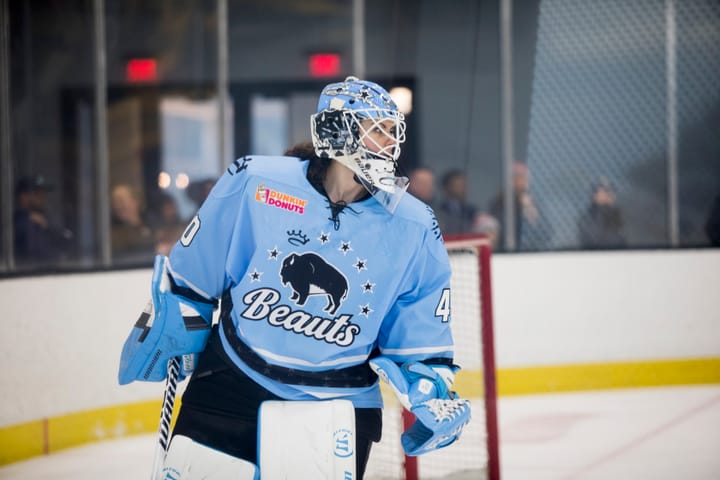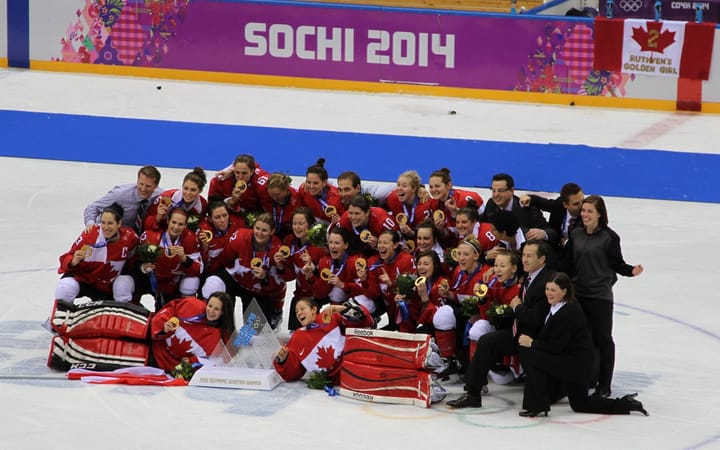What #ForTheGame could mean for Nordic hockey
“In unity there is strength.”
If you’re reading this, you know about #ForTheGame. You, like me, saw the coordinated blitz on social media, you probably watched it spread like wildfire, clicking ‘refresh’ again and again to see who was next.
And then, at 11:04, minutes after the biggest names in North American hockey posted their scheduled message, things got interesting.
We may represent different teams, leagues and countries but collectively we stand as one. #ForTheGame pic.twitter.com/UUUBLpIbJ5
— Michelle Karvinen (@Karvinen_33) May 2, 2019
Forward Michelle Karvinen, who plays her club hockey at Luleå Hockey/MSSK and internationally for Team Finland, became the first SDHL player to join in. The first, and far from the last.
Ronja Savolainen. Andrea Dalen. Jenni Hiirikoski. Pernilla Winberg. Fanny Rask. Lovisa Berndtsson. Sara Grahn. Eveliina Suonpää. The list goes on. Players across the league loaned their voices to the movement. In neighboring Finland, Kiekko-Espoo defender Minttu Tuominen did the same, the sole Naisten Liiga player (to the best of my knowledge) to do so.
It’s important to note that the #ForTheGame social media posts from European players in Finland and Sweden are not a declaration of an upcoming labor stoppage in their respective leagues. Many of the most famous names to post — like Hiirikoski, Grahn, and Tuominen — are already signed for next season.
AIK forward Frida Ekdahl described her decision to post to The Ice Garden:
“I felt it was important to show solidarity for the sport of women’s hockey. Because even though we come from different nations, even continents, and have different preconditions we all want the same thing; to be accepted in a ‘men’s sport’ and that girls one day will have the same possibilities as a male hockey player on the highest level, no matter country.”
Team Sweden head coach Ylva Martinsen, herself a former SDHL defender and Damkronorna Olympian, also took notice.
“For me the news of the movement is important even though I coach a national team,” she told The Ice Garden. “I think this is a matter for so many within the sport, who fought so long for a change for the better.”
The Issues
Inequality in women’s hockey is as old as the sport itself, and parallels run easily between Europe and North America.
Players in the SDHL and the Naisten Liiga are not able to financially support themselves with hockey alone. Some are students, others work as graphic designers, nurses, Air Force service members, and team General Managers, to name just a few.
Conditions, resources, and compensation where it’s available vary from team to team in both leagues. Luleå Hockey/MSSK, one of the finest-run women’s teams in the sport, established pay for all their senior players last season, as opposed to paying only some as they had been before. It’s still not a living wage, but enough to allow the team to reduce their job loads and train during the day instead of at night after a workday.
This, sadly, is the exception instead of the rule. There’s simply not enough investment in women’s hockey and the financial burden of bridging that gap often falls on players.
Which sucks. A lot.
The pay-to-play structure is still in place in many places across Finland; some teams are working to mitigate it as much as possible, but the cost remains a very real issue for even the country’s most elite players. The issue has sent some of Finland’s best players abroad, particularly to Sweden: out of 23 players rostered at the 2019 IIHF Women’s World Championships, 10 play their club hockey in the SDHL.
There’s also the issue of insurance. Naisten Liiga players pay for their own insurance, but the Finnish federation has a deal in place with one specific company to get them a very reduced rate for hockey.
Over in the SDHL, communications director Angelica Lindeberg told The Ice Garden: “At the moment the players don’t receive any insurance through the league but is one of many things we’re working with to arrange.”
A Different Structure
Both the SDHL and the Naisten Liiga are administered by their respective national federations, and the Swedish Ice Hockey Association recently extended its agreement with the SDHL through 2023. Neither USA Hockey nor Hockey Canada has (or had) any role in running the NWHL or the CWHL.
In other words, a #ForTheGame movement in Finland and Sweden would be in direct opposition of national governing bodies. The players, particularly younger ones trying to earn a spot on their national teams, have to ask if they’re willing to take that risk.
A Season Abroad?
Let’s say negotiations this offseason go totally nuclear. Full-on, scorch-the-earth-and-salt-its barren-dregs nuclear. Do the North Americans head to Europe? Are they wanted in Europe?
That depends on who you ask.
The debate about foreign players in the SDHL has raged for years. Everyone from Swedish Ice Hockey Association chairman Anders Larsson to Swedish Olympic Committee CEO Peter Reinebo have opted to scapegoat import players for the Damkronorna’s disappointing international results instead of actually dealing with their own organizations’ failures.
Related
Swedish Ice Hockey Association abruptly cuts subsidies for foreign players in SDHL
Despite the misgivings at the top, elite foreign talent is welcomed at an organizational level by clubs all across the league. 90 players from 17 countries around the world joined 145 Swedes last season, up from 77 in 2017-2018.
Former Calgary Inferno forward and 2019 Clarkson Cup champion Kelty Apperson has decided to try her luck in Sweden, the first boycotting North American to do so.
The first #ForTheGame player to sign overseas, former Calgary Inferno forward Kelty Appetson heads to the #SDHL and SDE. https://t.co/5Py4XnFkA3
— Meredith Foster (@fosterwrites) May 10, 2019
(Kelty, if you’re reading this, I’m sorry I spelled your name wrong on Twitter.)
If, say, Marie-Philip Poulin decided to sign with Brynäs (don’t strangle me, dear readers, this is purely hypothetical), she would be greeted in Gävle with open arms. Prior to the movement, Team Canada goaltender Ann-Renée Desbiens discussed the possibility of signing in Sweden once she’d finished graduate school. What’s to stop her now? After all, Leksand needs a goalie with Julia Åberg taking time off, so why not?
Former Team Sweden captain and retired HV71 forward Jenni Asserholt weighed in:
Svenska spelare- tävla, utmana bestämt och satsa samtidigt som kunskaps sinnena är påslagna. Toppen i Sverige (DK) kommer bevara sina roller i klubblag. Yngre spelare- köör, lär, tålamod och satsa långsiktigt!
— Jenni Asserholt (@JenniAsserholt) May 3, 2019
“Boycott of the NWHL can lead to national team players in USA and Canada looking towards Sweden. I rejoice - is it just me? Imagine the SDHL as the best league in the world, in Sweden! What a chance - all knowledge, experiences, skills, commercial interest, role models / idols, recruitment and retention. Swedish players - compete, challenge firmly and devote while the knowledge senses are turned on. The top in Sweden (Damkronorna) will maintain their roles in the club teams. Younger players - go learn, patience and devote long term!
The Naisten Liiga’s attitude to foreign players is markedly different. One of the issues brought up following the league’s rebrand in 2017 was creating a “competitive and attractive” environment for both Finnish talent and imports.
The teams carry bigger rosters, but the players are often younger and the skill level varies. Does Kendall Coyne Schofield want to go to Rauman Lukko, for example, and play on a team where the youngest player is 16 and the median age is 19.8? What about a winter in Kuopio with KalPa? Her speed would certainly be an asset; put her on Tanja Niskanen’s wing and see what happens. Heck, throw her on a line with Elisa Holopainen and watch them go.
Personally, I’m all for the best of the best North Americans heading across the Atlantic. If the #ForTheGame boycotters want to go play in Europe and are able to do so without disrupting the talent already in place, the attention they bring with them will only be a positive. Time and time (and time...and time...) again we hear about how little attention is paid to the women’s game. The media boost and the subsequent exposure from a wave of high-calibre talent would be tremendous.
The Bottom Line - For Now
So, then, what does #ForTheGame really mean for the SDHL and the Naisten Liiga?
From a practical standpoint, nothing yet. Displays of solidarity are important in labor movements and there’s no doubt that female hockey players all over the world are watching this movement just as keenly as their North American counterparts.
As Martinsen said, “We have the same struggle here in Sweden and maybe this can help us on our journey.”
Thanks to Erik Gustafsson for Swedish translation help.





Comments ()